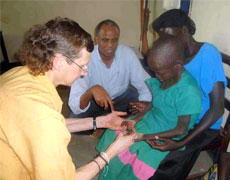 Health officials are baffled as they try to identify the cause and a cure for nodding syndromeFor the first time, researchers and scientists from different parts of the world have arrived at a standard case definition for nodding syndrome, previously known as ‘nodding disease’ or ‘head nodding disease’. Consensus was reached during the first international scientific meeting held on the disease in Kampala, Uganda, in August 2012.
Health officials are baffled as they try to identify the cause and a cure for nodding syndromeFor the first time, researchers and scientists from different parts of the world have arrived at a standard case definition for nodding syndrome, previously known as ‘nodding disease’ or ‘head nodding disease’. Consensus was reached during the first international scientific meeting held on the disease in Kampala, Uganda, in August 2012.
Nodding syndrome is a devastating illness that affects children between 5 and 15 years old. There is no known cure for the disease and its cause remains unknown. WHO first brought the disease to the attention of the world when it was investigating cases in south Sudan in 2001–2002. Earlier studies and descriptions of the disease from the 1960s onwards had been limited and treated with sceptism among neuroscientists.
Scientists from WHO and the Centers for Disease Control and Prevention (CDC), Atlanta, are now studying possible links between nodding syndrome and onchocerciasis, also known as river blindness.
About 93% of all nodding syndrome cases are reported from onchocerciasis-endemic areas creating a strong hypothesis for common risk factors between the two diseases. Cases have so far been reported in Uganda, South Sudan and Tanzania.
Nodding syndrome is characterized by head nodding episodes which are sometimes precipitated by the consumption of food or cold weather. They are often accompanied by convulsions or staring spells. During episodes, a child stops feeding and appears non‐responsive, with or without loss of consciousness. There is deterioration of brain function in some victims, and malnutrition with growth retardation in the majority of cases.
While anti-epileptic drugs may give relief from seizures in some children, the effectiveness of these drugs is questionable.
WHO is now advising governments to undertake mass treatment of onchocerciasis with ivermectin throughout affected districts and recommending health system strengthening as the best solution to tackle not only nodding syndrome but other neglected tropical diseases.
Related links
Nodding Syndrome meeting, researchers agree on case definition and establish research agenda
Hope as nodding syndrome screening and treatment centres are opened in northern Uganda


